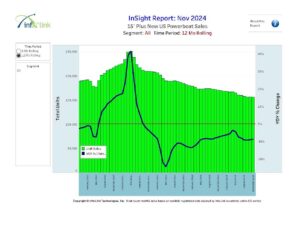My wife, Kay, bought a car from a local dealer in 2019. In the six years since the purchase, the salesman has faithfully sent us birthday, Christmas and anniversary cards.
You can guess what came next.
She decided it’s time for a new car. So, while she hadn’t seen the salesman in six years, she called him, looked over the choice of new models, and her new car is in our garage.
Clearly there was a connection with that salesman. Had he not believed it was a good business to send those annual greetings, the odds she would have even thought of him so many years later would have been nil. And the cards were simple greeting cards, not promotional pieces for the dealership, which separated them from typical direct-mail stuff that gets ignored.
Let’s face it, without people lining up in our showrooms these days to buy boats, being on the sales team can be frustrating. A salesperson spends time trying to figure out the best angle to approach a prospect, but despite best efforts, nothing is heard back, so he or she figures the sale is lost and eventually drops the prospect altogether.
Every sales training session I’ve attended ended by proclaiming the three most important aspects of selling: follow up, follow up and follow up. And it’s a reminder that to grow a dealership, finding ways to add value to each customer, as well as making them feel they’re valued, is a success formula. Recognition of a customer after the sale should be a centerpiece of every long-term marketing program. And something as simple as a birthday card can do it.
There’s always a much higher level of follow up, like a customer-appreciation day with a special in-store event. It can include a guest speaker with a great subject, refreshments, door prizes and family activities, and it should happen more than once a year.
Handing out coupons, mugs, tote bags, shirts, caps, key chains and other items to good customers is always a good idea. If your name is on it, how can they forget you? And while you’re at it, use the opportunity to find out about specific customer needs or desires by including things like comment cards or a survey.
The information you gain from comment cards could lead to offering new products or services or even improve existing ones. Taking time to learn something personal about customers through follow up and acting on that knowledge can lead to genuine loyalty. Moreover, loyalty can further result in a customer becoming an advocate for the dealership with family, friends and co-workers. It can even lead to some wider recognition for the dealership as someone might post a great comment online.
Treating customers well and going an extra mile to thank them for their business is the least every salesperson should be doing. With a little creativity, it can be the best way to keep existing customers coming back.
Topping it all, show gratitude. It takes more than just a one-time thank you email. Building loyalty and a desire to return takes time and calls for an ongoing effort. Sadly, it’s often one and done for some dealers (and manufacturers) who offer good promotional deals to first-time buyers but have no plan to retain them.
No one is suggesting you give a discount every time a customer walks through the door, but a strategy of personalized offers based on purchasing history, special interests, birthday recognitions and occasional incentives can help keep customers engaged with your sales team.
Far too many businesses are in a race to the bottom by primarily trying to offer a lower price than their competitors. But when there’s a reminder of a past good experience for the customer, the odds of repeat business skyrocket.
ASA To Host Tariff Briefing
If you’re a dealer in fishing boats, you may want to tune into an American Sportfishing Association virtual briefing this Friday, April 4, at 4 p.m. (ET). It will address upcoming tariffs that are expected to impact the sportfishing industry.
The Trump Administration has labelled April 2 as “Liberation Day,” when a round of fresh tariffs will be revealed. It’s claimed they’ll be focused on easing trade imbalances with nations that export more goods to the United States than they import from America. These tariff actions will likely target the 15 countries that make up the bulk of the U.S. trade deficit, including China, Canada, Mexico, Japan, Korea, Taiwan and the European Union.
The briefing will include representatives from ASA’s trade firm, Sorini, Samet & Associates, who will provide an overview of what is announced April 2 and answer questions from ASA members about reciprocal tariffs and other trade actions.










